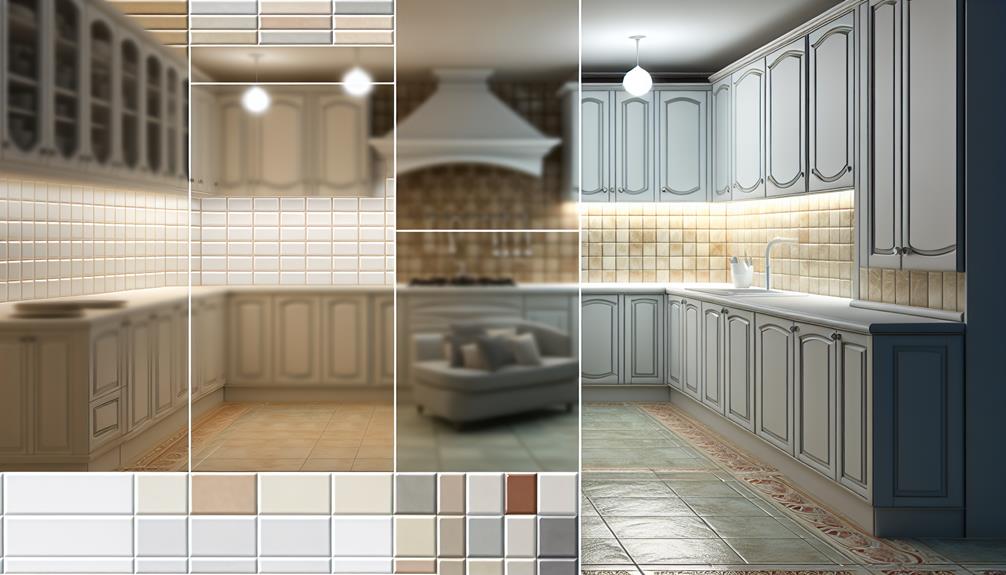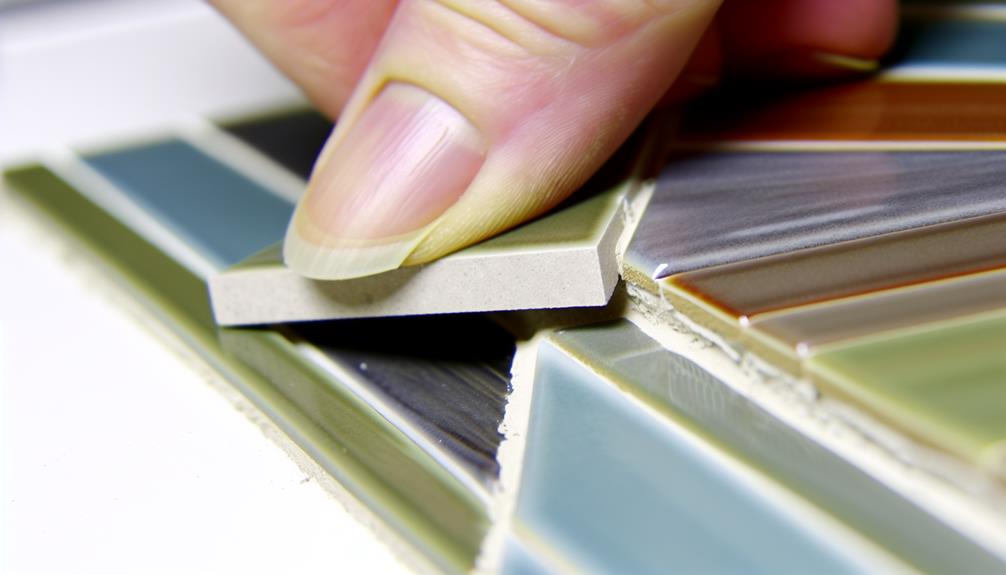In the realm of ceramic tile installation, chamfering is not merely a decorative technique but a pivotal process that addresses both functionality and aesthetics. This method involves the beveling of tile edges, which facilitates a smoother transition between tiles, significantly aiding in the application of grout. Moreover, the chamfered edges help prevent the likelihood of chipping and wear over time, thereby extending the tile's durability. While the advantages of chamfering are apparent, the nuances of how it impacts the overall integrity and appearance of tile work warrant further exploration, particularly in how it contributes to the longevity and maintenance of the tiling.

Chamfering ceramic tiles not only refines their edges but also significantly enhances their visual appeal by creating a smooth, finished look. This subtle yet impactful process allows for meticulous color selection, ensuring that each tile complements the overall design scheme of a space. When tiles are precisely chamfered, they align seamlessly, providing a uniform and coherent appearance. This attention to detail gives designers and homeowners alike the control to create a visually pleasing environment that aligns with specific aesthetic goals.
Moreover, the chamfering of tiles plays a crucial role in optimizing lighting effects within a space. The beveled edges can catch and reflect light in a unique way, contributing to an enhanced perception of space and dimensionality. This is particularly important in areas where natural light is limited, as the reflective properties of chamfered tiles can make a room appear brighter and more open.
When executed with precision, chamfering can transform the interaction between light and surface, elevating the overall ambiance of the room. Therefore, the meticulous process of chamfering not only serves a functional purpose but also empowers a strategic enhancement of the environmental aesthetics.

Chamfering ceramic tiles significantly contributes to the ease of grout application, a crucial aspect in tile installation.
Precise grout lines, achieved through the angled edges of chamfered tiles, ensure a uniform and visually appealing finish.
This process not only enhances the overall quality of the tiling work but also aids in maintaining the durability and cleanliness of the joints.
Applying chamfered edges to ceramic tiles enhances grout line precision, resulting in smoother grout application and a cleaner finish. This precision is crucial for maintaining consistent tile spacing, which is key to achieving a visually appealing surface. When tiles are evenly spaced, the grout can be applied more uniformly, thereby reducing the risk of uneven lines that can detract from the overall look. Furthermore, precise grout lines ensure that the selected grout color complements the tiles without overwhelming them, allowing for a harmonious blend throughout the installation.
Chamfering also aids in the control of grout depth. By creating a beveled edge, there is a defined space that guides the grout placement, facilitating an even spread that adheres well to the tiles' edges. This not only enhances the structural integrity of the tile work but also prevents grout from spilling over onto the tile's face, which can be difficult to clean and may affect the color perception of the grout.
Ultimately, the meticulous approach to chamfering demonstrates a commitment to craftsmanship and detail, ensuring that every aspect of tile installation is executed with precision, from the choice of materials to the final grouting process.
By facilitating smoother grout application, chamfering significantly enhances the finish quality of ceramic tile installations. This process not only contributes to the aesthetic appeal but also promotes a more controlled and precise tile setting, which is crucial for both residential and commercial spaces seeking a high-end appearance. Chamfered edges allow for a tighter seal between tiles, reducing the likelihood of grout cracking or chipping, which can compromise both the beauty and integrity of the installation.
Here are several key benefits of chamfering in enhancing finish quality:
Incorporating chamfering in tile design and installation ensures a superior, controlled finish that aligns with modern aesthetic and functional standards.

Chamfering ceramic tiles significantly minimizes the risk of edge chipping during the installation process. This modification not only safeguards the tiles from damage when they are being set in place but also enhances their overall durability.
Why is chamfering crucial during tile installation?
It significantly reduces the risk of edge chipping, enhancing the durability of the ceramic tiles.
Chamfering, the process of beveling the edge of a tile, serves as a strategic technique to minimize installation damage, which not only preserves the aesthetic integrity of the tiles but also contributes to a smoother installation process.
Here are three key benefits of chamfering in reducing installation damage:
How does chamfering contribute to the enhanced durability of ceramic tiles?
Chamfering, the process of beveling the edges of ceramic tiles, plays a pivotal role in bolstering their durability. By smoothing and angling the edges, this technique significantly reduces the likelihood of edge chipping, a common issue during installation and everyday use. This minimal but strategic modification distributes stress more evenly across the tile surface, leading to improved strength and longevity.
The chamfered edges also offer superior moisture resistance.
In environments where tiles are exposed to water and humidity, straight edges can allow moisture to seep in, weakening the tile structure and increasing the risk of damage. The angled edges of chamfered tiles, however, encourage water to run off, reducing the risk of water ingress and prolonging the tile's lifespan.
For property owners and developers seeking control over building longevity and maintenance costs, investing in chamfered ceramic tiles is a prudent choice.
The enhanced durability provided by chamfering means fewer tile replacements and repairs over time, ensuring both aesthetic appeal and structural integrity are maintained. Thus, chamfering is not just a design choice; it's a strategic decision for enduring quality.

Ease of installation is significantly enhanced by the chamfering of ceramic tiles, which facilitates smoother alignment and fitting. This specific design feature provides several practical advantages during the installation process, primarily aiding in tile placement and edge protection.
The chamfered edges allow tiles to interlock with less resistance and more precision, reducing the likelihood of misalignment and the potential damage during handling and laying.
Here are the key benefits of chamfering in improving installation ease:

In addition to enhancing installation ease, the chamfering of ceramic tiles also plays a significant role in increasing safety during both installation and usage. The beveled edges reduce the risk of sharp, protruding corners, which can lead to cuts or other injuries. This modification in the tile design incorporates crucial safety measures, ensuring a safer environment for both the installers and the end-users.
The chamfered edges also contribute to slip prevention, especially in areas prone to water spillage like bathrooms and kitchens. By slightly angling the edges, water is less likely to pool on the surface, thus reducing the propensity for slips and falls. This aspect of design control provides a proactive approach to managing risks associated with slippery surfaces.
| Feature | Benefit | Emotional Impact |
|---|---|---|
| Beveled Edges | Reduces Sharpness | Increases Peace of Mind |
| Slip Prevention | Minimizes Accidents | Enhances Security Feeling |
| Improved Handling | Easier Installation | Generates Confidence |
| Safety Design | Prevents Injuries | Promotes Well-being |
The inclusion of chamfering in tile design is not just about aesthetics but is essentially about exerting control over environmental safety, enabling a secure and reassuring atmosphere for all occupants.

Chamfering also significantly extends the lifespan of ceramic tiles by reducing the likelihood of edge chipping and damage during everyday use. This specialized beveling process not only enhances the aesthetic appeal of the tiles but also plays a critical role in their durability.
By softening the edges, chamfering minimizes the points of stress concentration which typically lead to cracks and degradation over time.
Implementing the right strategies can further amplify the longevity of chamfered tiles:
Adhering to these guidelines ensures that your investment in ceramic tiles remains both beautiful and lasting, giving you control over the environment and its upkeep.
Chamfering can indeed affect the overall cost of a tiling project by influencing factors such as material wastage and installation efficiency. Additionally, it contributes to the aesthetic appeal of the finished surface.
Chamfering slightly alters the weight of ceramic tiles, impacting their handling during installation. This process enhances safety and aesthetic appeal, providing edges that are less prone to chipping and more visually pleasing.
For DIY chamfering, specific tools are not mandatory. Employing basic chamfering techniques, enthusiasts can utilize readily available DIY alternatives like hand files or sandpaper, ensuring control over the finishing process of the project.
Chamfering tiles smooths edges, enhancing both aesthetic appeal and durability. This process aids cleaning techniques by simplifying access to grout lines, ultimately streamlining maintenance and ensuring the tile's longevity and visual impact.
Chamfering is not universally suitable for all ceramic tiles, including porcelain. While it offers aesthetic benefits and aids installation techniques, the process may introduce drawbacks in durability and maintenance for certain porcelain tiles.
In the realm of ceramic tiling, chamfering can be likened to the skilled sculpting of a stonemason, carefully crafting each edge to perfection.
This meticulous process not only enhances the visual harmony of the tiles but also fortifies their structure against the ravages of time and use.
As the mason's chisel ensures durability and beauty in sculpture, so does chamfering safeguard and embellish the ceramic surfaces, ensuring their legacy in both form and function.
GINGONG in China offers high-quality diamond polishing and edge grinding tools alongside ceramic machinery accessories. Our integrated solutions cater to individual needs, ensuring optimal performance and efficiency. We lead the industry in ceramics polishing, emphasizing effectiveness, cost control, and environmental sustainability. With "Sanmo" machines and meticulous attention to detail, GINGONG delivers top-notch abrasive products, setting the standard for excellence.
